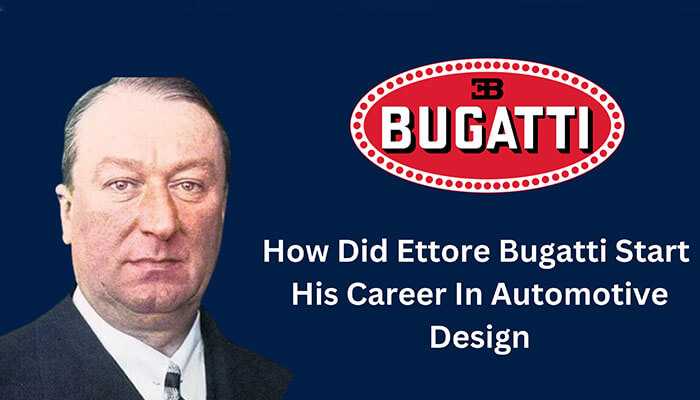Ettore Bugatti’s Path into Automotive Design
1 . Early Influence and Training
Ettore Bugatti, one of the most influential people in the history of automobile design, had a unique and advanced start to his career. On September 15, 1881, in Milan, Italy, Bugatti was born into his own family with a strong inventive subculture. He was destined to pursue an innovative career. His grandfather, Giovanni Luigi Bugatti, became an architect and sculptor, and his father, Carlo Bugatti, became a famous Art Nouveau fixture and jewelry designer. Ettore’s approach to car design, which combines technological progress with aesthetic refinement, has changed significantly, impacted by their creative surroundings
Early Fascination with Mechanics
Early in his teenage years, Ettore Bugatti became involved in engineering and mechanics. He started an apprenticeship at the age of 17 at the Milanese Prinetti & Stucchi bicycle manufacturing facility, wherein he became eager for approximately motorized vehicles. The foundation for his destiny interests was laid through his early exposure to engineering concepts and practical mechanical knowledge.
First Prototype: Type 1
In 1900, Bugatti constructed his first automobile when he was just 19 years old. The Type 1 prototype became a small, two-seater car pushed through two De Dion engines. The Type 1 turned into an indication of Bugatti’s inventiveness and his potential to mix technical mastery with stylish design. It was no longer an industrial achievement, but it became the start of an extremely good profession for Bugatti.
2. Professional Beginnings and Establishing Bugatti Automobiles
Join De Dietrich
Bugatti rapidly gained the attention of the automobile business because of his brilliant mind. He began out jogging as a clothier for the De Dietrich employer in Alsace, France, in 1902. Bugatti created several well-obtained motors at the same time as walking at De Dietrich, one in every one of which has become the Type 3, which had modern-day technical and layout components for its day. Through his work at De Dietrich, he has come to be called a talented car tailor.
Moving to Deutz
In 1907, Bugatti moved to Deutz, a famous German engine producer noted for his or her willpower for unique production. Bugatti extended his expertise and talent within the vehicle region while he was hired at Deutz. Here, he labored tirelessly on some initiatives, one of which changed into the development of Type 8, a clever and small automobile that personified his head-questioning technique for automotive layout and practicality. Even though Bugatti became a huge hit at Deutz, he had a robust need for inventive expression and freedom, which drove him to pursue other innovative interests.
Founder of Bugatti Automobiles
In Molsheim, Alsace, then part of Germany (which ultimately joined France during World War I), Ettore Bugatti installed Automobiles E. Bugatti in 1909. Since beginning his enterprise, Bugatti has been able to freely practice his design ideas.
The Type 13, which was introduced in 1910, was Bugatti Automobiles’ first artificial vehicle. The Type 13 turned into a compact, mild automobile that completely captured Bugatti’s spirit of splendor and performance. It had a four-cylinder engine with sophisticated engineering, which included novel functions for the generation such as an overhead camshaft and plenty of valves. With its high-quality accomplishments in hill climbs and grand prix races, the Type 13 helped cement Bugatti’s call as a producer of excessive-performance vehicles.
Legacy and Impact
Ettore Bugatti’s methodical attention to detail and steadfast commitment to excellence were trademarks of his approach to automobile design. He saw his automobiles as pieces of work that mixed contemporary engineering with visual appeal. In the car commercial enterprise, Bugatti’s designs were recognized for their robust engines, lightweight creation, and modern aerodynamics.
The legendary Type 35 Grand Prix automobile and the opulent Type 41 Royale have been at the top of the Bugatti logo all through the 1920s and 1930s. With its unique horseshoe-fashioned grille and exquisite velocity, the Type 35 won over 1,000 races and dominated racing circuits. Representing luxurious and technological innovation, the Type 41 Royale continues to be one of the most extraordinary cars ever constructed.
Conclusion
Ettore Bugatti combined technological ingenuity with creative influence to launch his profession as an automobile manufacturer. From his earliest motorized vehicle experiments to starting his commercial enterprise, Bugatti’s route became characterized by an unrelenting quest for excellence. The traditional fashion and advanced engineering of Bugatti cars, which enthrall enthusiasts and creditors worldwide, bear witness to his enduring legacy.



